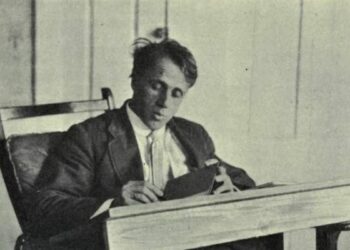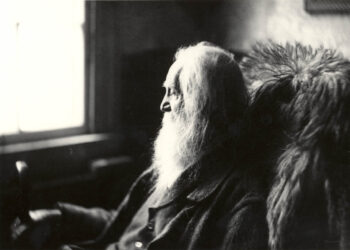Table of Contents
ToggleIntroduction
Because I Could Not Stop For Death By Emily Dickinson Emily Dickinson, one of the most renowned American poets, wrote Because I Could Not Stop for Death around the 1860s, a period during which themes of mortality, existence, and transcendence were central to her work. This poem, one of her best-known and widely anthologized pieces, delves into the concept of death, the inevitability of mortality, and the relationship between life and death. Dickinson’s distinctive style, her use of dashes, paradoxes, and vivid imagery, serves to make this reflection on mortality both haunting and meditative.
In Because I Could Not Stop for Death, Dickinson personifies death as a calm, patient driver who arrives not in fear or aggression but as an inevitable, civil force. The speaker’s journey with death is one of acceptance, and the poem explores the themes of time, the afterlife, and the passage from life to death. Through her portrayal of death as a gentle, unhurried force, Dickinson presents a uniquely calm and contemplative view of a subject often depicted in a more dramatic or fearful manner.
Summary of the Poem
Because I Could Not Stop for Death begins with the speaker recounting an encounter with death, who arrives not in haste, but in a courteous and deliberate manner. The speaker notes that she “could not stop for Death,” but “Death kindly stopped for me,” suggesting that death is not an aggressive force but one that arrives at its own time, with patience and gentleness.
The poem continues with the speaker describing the journey that ensues after death’s arrival. She is transported in a carriage, with “Death” as the driver and “Immortality” accompanying them. The carriage ride is symbolic of the journey from life to death, and the speaker reflects on the scenes they pass along the way. As they travel, the speaker sees the “School,” the “Grain,” and the “Setting Sun,” which represent different stages of life—youth, maturity, and the end of the day. These stages serve as metaphors for the passage of time and the fleeting nature of life.
Read more
As the ride progresses, the speaker becomes aware that she is moving toward an unknown destination, symbolizing the transition from life to death and, by extension, the afterlife. The carriage stops at a “House,” which, upon closer examination, appears to be a grave. This final destination is where the journey ends, and the speaker realizes that the ride with Death has been a journey not just through physical space but through time itself, with the end of the ride marking the speaker’s transition from life to eternity.
In the final stanza, the speaker reflects on the fact that although time has passed and centuries have gone by, she still feels as though the journey with Death happened “but yesterday.” This reflects Dickinson’s idea of the eternal nature of the soul and the timeless quality of death. The passage of time no longer matters in the face of eternity, and the speaker comes to terms with the idea of death as a natural, albeit mysterious, process.Because I Could Not Stop For Death By Emily Dickinson

Themes in Because I Could Not Stop for Death
Because I Could Not Stop For Death By Emily Dickinson Emily Dickinson’s Because I Could Not Stop for Death is rich with complex themes that explore the relationship between life and death, time, immortality, and the afterlife. Below are the central themes of the poem:
1. The Personification of Death
Because I Could Not Stop For Death By Emily Dickinson In the poem, Dickinson personifies Death, not as a fearsome or malevolent force, but as a polite and patient suitor. Death is described as a “kindly” figure who “stops” for the speaker when she is not ready. This personification of death as a courteous and almost gentle figure stands in stark contrast to more conventional depictions of death in literature, which often focus on fear, violence, or suddenness. By personifying death in such a way, Dickinson offers a more nuanced and contemplative view of mortality.
Death, in Dickinson’s poem, is not depicted as something to be avoided or feared, but rather as an inevitable companion who is always present, waiting for its time. This portrayal is important because it emphasizes the inevitability of death and suggests that, rather than resisting it, one should accept it as a part of life’s natural progression.
Read more
2. The Passage of Time
Because I Could Not Stop For Death By Emily Dickinson The theme of time is central to Because I Could Not Stop for Death. The carriage ride represents the journey through time, with each stage of the journey symbolizing a different period in the speaker’s life. As the carriage passes the “School,” “Grain,” and “Setting Sun,” the speaker reflects on the different stages of human existence—youth, adulthood, and the end of life. This journey underscores the fleeting nature of time and the inevitability of aging and death.
Because I Could Not Stop For Death By Emily Dickinson The poem also contrasts the urgency of life with the slow, almost casual passage of time in death. While the speaker is aware that time is passing, it no longer has the same urgency it once did. The journey with Death is unhurried, and time becomes an abstract, unimportant concept once death has arrived. This theme invites readers to reflect on how they use time in life, as well as the realization that time may seem endless while living but can feel fleeting when viewed in retrospect.Because I Could Not Stop For Death By Emily Dickinson
3. The Afterlife and Immortality
Because I Could Not Stop For Death By Emily Dickinson The presence of “Immortality” in the carriage symbolizes the afterlife and eternity. This figure suggests that death is not the end of existence but a transition to something beyond the physical world. Dickinson implies that while death may represent the end of one phase of existence, it leads to the beginning of another, one that is timeless and eternal.
The final stanza, where the speaker reflects that “Centuries” have passed “since then,” highlights the idea that in death, time loses its significance. The speaker, now existing in eternity, experiences a sense of timelessness. The notion that death leads to a form of immortality, where the passage of time no longer matters, is an important part of the poem’s overall message. Death, while marking the end of life, is not portrayed as an end but rather as a transition to a more lasting, eternal state.Because I Could Not Stop For Death By Emily Dickinson
4. The Nature of Mortality and the Inevitable End
Because I Could Not Stop For Death By Emily Dickinson At the heart of Because I Could Not Stop for Death lies an exploration of mortality itself. The poem speaks to the inevitability of death and the transition from life to death that everyone must face. Dickinson presents the moment of death as a natural, albeit mysterious, occurrence. The speaker is neither resisting nor embracing death; instead, she is simply acknowledging it as an unavoidable fact.
Because I Could Not Stop For Death By Emily Dickinson The imagery in the poem reinforces the idea that life is fleeting and that death comes for everyone, regardless of one’s readiness. The use of the carriage ride as a metaphor for the journey of life emphasizes the inevitability and the continuity of life and death. The poem suggests that death is not something to be feared, but something to be accepted as a natural part of the human experience.
5. The Paradox of Life and Death
Because I Could Not Stop For Death By Emily Dickinson Dickinson’s poem is filled with paradoxes, particularly the contrast between life and death, the living and the eternal. The idea that death is “kindly” and “civil” is a paradox in itself, as death is traditionally seen as something grim or fearful. Similarly, the speaker’s reflection that centuries have passed “but still feels shorter than the day” suggests a paradoxical relationship between time and eternity. The poem creates a sense of timelessness where life and death merge into one continuous experience, highlighting the idea that the two are intertwined and inseparable.Because I Could Not Stop For Death By Emily Dickinson

Conclusion
Because I Could Not Stop For Death By Emily Dickinson Emily Dickinson’s Because I Could Not Stop for Death offers a profound meditation on the nature of mortality, the passage of time, and the eternal journey from life to death. Through her personification of death, the symbolic imagery of the carriage ride, and the reflection on immortality, Dickinson creates a timeless reflection on the inevitability of death and its role in the human experience.
By presenting death not as a fearsome force but as a patient and even courteous companion, Dickinson challenges readers to rethink their views on death and the afterlife. Through this poem, Dickinson invites us to consider death not as an end, but as a part of a continuous, timeless cycle, where time loses its meaning and the soul continues on into eternity. In this way, Because I Could Not Stop for Death remains one of Dickinson’s most enduring and insightful works, offering a meditative reflection on the universal experience of mortality.Because I Could Not Stop For Death By Emily Dickinson
Read more
FAQ
1. What does the carriage symbolize in the poem?
The carriage in the poem symbolizes the journey from life to death. It is a vehicle that transports the speaker from the physical world to the unknown realm of death and the afterlife. The carriage ride serves as a metaphor for the passage of time and the inevitable transition from life to death, with death as the patient driver who guides the speaker through this journey.
2. Why is death personified as a “kindly” figure?
In the poem, death is personified as a courteous and patient figure to challenge the traditional view of death as something to fear or resist. By depicting death as “kindly,” Dickinson invites the reader to reconsider their view of mortality. Rather than seeing death as an end, she presents it as a natural part of life’s cycle, something that comes when the time is right and in a calm, non-aggressive manner.
3. What is the significance of “Immortality” in the poem?
“Immortality” in the poem symbolizes the afterlife and the timelessness of the soul. It represents the idea that death is not the end of existence, but rather a transition into an eternal state. The presence of Immortality in the carriage with Death suggests that the speaker’s journey does not conclude with death but continues into eternity, where time loses its significance.
4. How does Dickinson portray the passage of time in the poem?
The passage of time is portrayed as both urgent and unimportant. On the one hand, the speaker is aware that time is passing as she journeys with Death, noting the stages of life (youth, maturity, and the end of day). On the other hand, the poem suggests that once death has arrived, time becomes irrelevant. The final lines suggest that the speaker has entered eternity, where the passage of centuries feels like a brief moment, highlighting the timelessness of death.
5. What is the poem’s message about death and immortality?
The poem suggests that death is not something to be feared but is a natural, inevitable part of life. It also implies that death leads to immortality, as the soul continues its journey beyond the physical world. Dickinson’s portrayal of death as a “kindly” figure emphasizes the calm and inevitability of mortality, while the presence of “Immortality” suggests that death is simply a transition to an eternal existence.
Read more

















